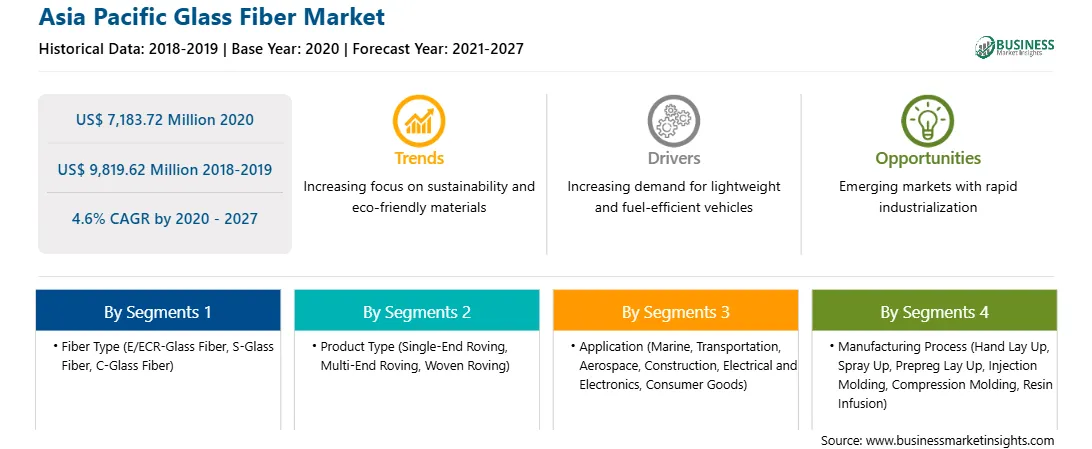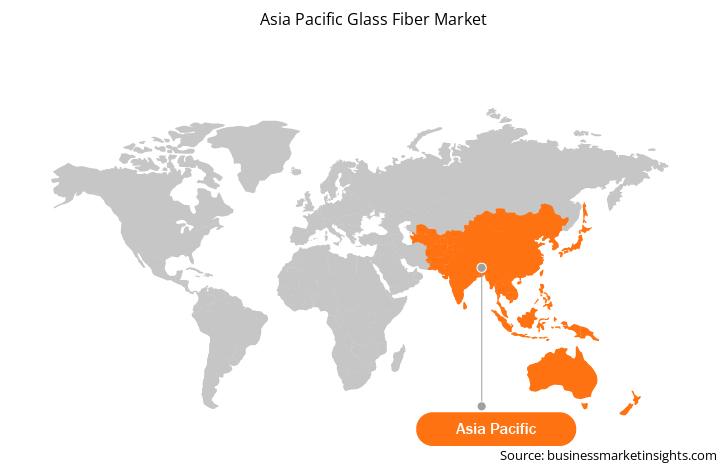APAC region comprises several developing economies such as China, India, Japan, South Korea, Australia, among others. These emerging nations are witnessing an upsurge in the middle-class population, coupled with growth in urbanization, offering massive opportunities for the key market players in the glass fiber market. The Glass fiber industry in the countries of APAC has experienced a considerable shift over the years. The massive growth of the Asia-Pacific region is due to a manufacturing base in the emerging economies, such as India, Japan, China, South Korea, Singapore, Taiwan, and Indonesia have large manufacturing industries. Rising automotive sales in the APAC (APAC) countries, including India and China, has been one of the most encouraging growth factors for the glass fiber market in recent years. Increasing consumer spending power and improving lifestyle, mainly in India, China, Japan, and Indonesia, have triggered air traffic, which will boost demand for aircraft and positively impact the glass fiber market size during the forecast period. The APAC encompasses a massive number of opportunities for the growth of Glass fiber. The region has surfaced as one of the prominent markets for the utilization of Glass fiber. China and India are the major contributors for the market. The rising demand for Glass fiber in the APAC region has attracted the manufacturers to establish their presence in the region that has further fueled the demand for the glass fiber market in the APAC. This shift has fueled the growth of the market in the region. Rising expenditure towards innovations and development activities, to diversify the application base of Glass fiber has also led to market growth.
In case of COVID-19, APAC is highly affected specially India. The COVID-19 is anticipated to cause a significant economic loss in the APAC region. The consequence and impact can be even worse and totally depends on the spread of the virus. The governments of various APAC countries are taking possible steps to restrict the spread of the virus by announcing lockdown, which in turn has negatively impacted the revenue generated by the market. The Government have asked the chemical & materials manufacturers to delay their production which will adversely affect the global supply of glass fiber. Furthermore, travel bans imposed by countries in APAC region are affecting opportunities for business collaborations and partnerships. All of these factors are expected to have a negative impact on the chemical and materials industry, acting as a stifling factor for the growth of various markets related to this industry in the coming months.

Strategic insights for the Asia Pacific Glass Fiber provides data-driven analysis of the industry landscape, including current trends, key players, and regional nuances. These insights offer actionable recommendations, enabling readers to differentiate themselves from competitors by identifying untapped segments or developing unique value propositions. Leveraging data analytics, these insights help industry players anticipate the market shifts, whether investors, manufacturers, or other stakeholders. A future-oriented perspective is essential, helping stakeholders anticipate market shifts and position themselves for long-term success in this dynamic region. Ultimately, effective strategic insights empower readers to make informed decisions that drive profitability and achieve their business objectives within the market.

| Report Attribute | Details |
|---|---|
| Market size in 2020 | US$ 7,183.72 Million |
| Market Size by 2027 | US$ 9,819.62 Million |
| Global CAGR (2020 - 2027) | 4.6% |
| Historical Data | 2018-2019 |
| Forecast period | 2021-2027 |
| Segments Covered |
By Fiber Type
|
| Regions and Countries Covered | Asia-Pacific
|
| Market leaders and key company profiles |
The geographic scope of the Asia Pacific Glass Fiber refers to the specific areas in which a business operates and competes. Understanding local distinctions, such as diverse consumer preferences (e.g., demand for specific plug types or battery backup durations), varying economic conditions, and regulatory environments, is crucial for tailoring strategies to specific markets. Businesses can expand their reach by identifying underserved areas or adapting their offerings to meet local demands. A clear market focus allows for more effective resource allocation, targeted marketing campaigns, and better positioning against local competitors, ultimately driving growth in those targeted areas.

The APAC glass fiber market is expected to grow from US$ 7,183.72 million in 2020 to US$ 9,819.62 million by 2027; it is estimated to grow at a CAGR of 4.6% from 2020 to 2027. Glass fibers are used for insulation, surface coating, cladding, and roofing raw material in the construction sector. They are inexpensive and possess mechanical properties such as stiffness, flexibility, transparency, resistance to chemical outbreak and inertness approximately equal to other fibers, including polymers and carbon fibers. Glass fibers are used in glass fiber reinforced concrete, which is utilized in the construction of walls, fireplace surrounds, foundations, cladding, vanity tops, and concrete countertops. It is mainly used in exterior building facade wall panels and as architectural precast concrete. Glass fibers act as the main carrier providing high tensile strength and making the concrete flexible and resistant to cracking. Alkali-resistant glass fibers (ARGF) are widely used in construction materials. ARGFs significantly improve the tensile strength, flexural toughness, modulus of rupture, and wearing resistance of concrete. Such concrete is used for crack prevention, thus, finds wide applications in the construction sector. Rapid development of the construction industry is expected to increase the demand for glass fibers. New construction of residential buildings in developing countries across APAC region is supporting the demand for glass fibers. For instance, strong economic growth of emerging markets, such as China and India, is resulting into robust infrastructural development. These countries are experiencing an increase in construction of new buildings; maintenance and repairs, remodeling, or renovating of existing structures; on-site assembly of precut; construction of temporary buildings; and installation of specialized building utilities such as elevators and escalators. All these factors are anticipated to create consistent demand for glass fibers in the construction industry across APAC region.
In terms of fiber type, the E/ECR glass fiber segment accounted for the largest share of the APAC glass fiber market in 2019. In terms of product type, the others segment held a larger market share of the APAC glass fiber market in 2019. In terms of application, the transportation segment held a larger market share of the APAC glass fiber market in 2019. Further, the others segment held a larger share of the APAC glass fiber market based on manufacturing process in 2019.
A few major primary and secondary sources referred to for preparing this report on the APAC glass fiber market are company websites, annual reports, financial reports, national government documents, and statistical database, among others. Major companies listed in the report are China Jushi Co., Ltd.; Chongqing Polycomp International Corp. (CPIC); Goa Glass Fibre Limited; Johns Manville; Nippon Electric Glass Co.,Ltd.; Owens Corning; SAINT GOBAIN S.A.; Sichuan Weibo New Material Group Co., Ltd.; Taishan Fiberglass Inc. (CTG); and Taiwan Glass Group.
The Asia Pacific Glass Fiber Market is valued at US$ 7,183.72 Million in 2020, it is projected to reach US$ 9,819.62 Million by 2027.
As per our report Asia Pacific Glass Fiber Market, the market size is valued at US$ 7,183.72 Million in 2020, projecting it to reach US$ 9,819.62 Million by 2027. This translates to a CAGR of approximately 4.6% during the forecast period.
The Asia Pacific Glass Fiber Market report typically cover these key segments-
The historic period, base year, and forecast period can vary slightly depending on the specific market research report. However, for the Asia Pacific Glass Fiber Market report:
The Asia Pacific Glass Fiber Market is populated by several key players, each contributing to its growth and innovation. Some of the major players include:
The Asia Pacific Glass Fiber Market report is valuable for diverse stakeholders, including:
Essentially, anyone involved in or considering involvement in the Asia Pacific Glass Fiber Market value chain can benefit from the information contained in a comprehensive market report.